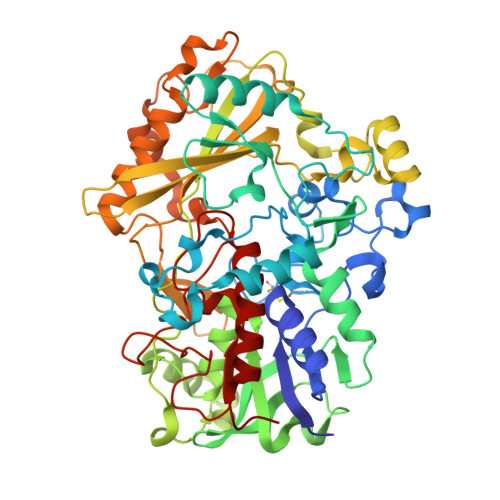Crystal Structure of the Flavoprotein Domain of the Extracellular Flavocytochrome Cellobiose Dehydrogenase
Hallberg, B.M., Henriksson, G., Pettersson, G., Divne, C.(2002) J Mol Biology 315: 421-434
- PubMed: 11786022
- DOI: https://doi.org/10.1006/jmbi.2001.5246
- Primary Citation of Related Structures:
1KDG - PubMed Abstract:
Cellobiose dehydrogenase (CDH) participates in the degradation of cellulose and lignin. The protein is an extracellular flavocytochrome with a b-type cytochrome domain (CYT(cdh)) connected to a flavodehydrogenase domain (DH(cdh)). DH(cdh) catalyses a two-electron oxidation at the anomeric C1 position of cellobiose to yield cellobiono-1,5-lactone, and the electrons are subsequently transferred from DH(cdh) to an acceptor, either directly or via CYT(cdh). Here, we describe the crystal structure of Phanerochaete chrysosporium DH(cdh) determined at 1.5 A resolution. DH(cdh) belongs to the GMC family of oxidoreductases, which includes glucose oxidase (GOX) and cholesterol oxidase (COX); however, the sequence identity with members of the family is low. The overall fold of DH(cdh) is p-hydroxybenzoate hydroxylase-like and is similar to, but also different from, that of GOX and COX. It is partitioned into an FAD-binding subdomain of alpha/beta type and a substrate-binding subdomain consisting of a seven-stranded beta sheet and six helices. Docking of CYT(cdh) and DH(cdh) suggests that CYT(cdh) covers the active-site entrance in DH(cdh), and that the resulting distance between the cofactors is within acceptable limits for inter-domain electron transfer. Based on docking of the substrate, cellobiose, in the active site of DH(cdh), we propose that the enzyme discriminates against glucose by favouring interaction with the non-reducing end of cellobiose.
- Department of Cell and Molecular Biology, Structural Biology, Biomedical Centre, Uppsala University, SE-751 24 Uppsala, Sweden.
Organizational Affiliation:






















